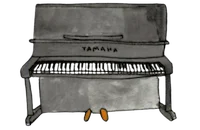Yamaha GB1 Baby Grand Piano Review & Information

The Yamaha GB1 baby grand piano (now known as the GB1K) is Yamaha’s most basic grand piano model but have Yamaha cut too many corners in order to keep the size and the price down? If you have any technical info or corrections for this article, please email mgpianos@gmail.com.
Is it too small?
The Yamaha GB1 is just 151cm long and pianos this small have very short bass strings. Small strings can produce a slightly “thuddy” or “tubby” sound in the bottom 2 or 3 octaves. Longer bass strings produce a much better tone, this is why concert grand pianos are soooo loooong.
Scroll to the 50 seconds mark on this video and you’ll hear the GB1 bass notes being demonstrated. The pianists say that they sound better than many baby grands of that size and he is probably correct but have a listen and see what you think
You can see a GB1 playing itself on this next video. It sounds a lot better on this recording but perhaps a little bright?
For comparison have a listen to the smooth, rich bass on this Yamaha C5 to hear what the extra 49cm gets you.
Sounds great doesn’t it? Can you stretch your budget and space to go for anything longer than a GB1?
Where is the Yamaha GB1 made?
The GB1/GB1K is made in Indonesia. Yamaha produce pianos all over the world and has factories in China, Japan, Taiwan, Indonesia, and the United States. For the very best quality you should look for pianos made in Japan as that is where Yamaha make many of their very best pianos such as their CFIIIS concert grand piano and their Yamaha U3 and other high-end upright and grand pianos.
Brand New Price for a GB1/GB1K
Prices may differ depending on your exact location and the shop you buy from but Yamaha puts the suggested retail price at somewhere between £9,700 and £11,000 depending on the color and finish you buy. If you have £9000-£11,000 to spend on a baby grand piano you might want to pause and see if you can find a little-used or properly reconditioned Japanese baby grand instead. The C1, C2, G1 or G2 are obvious choices that spring to mind. More on that later.
What Piano Technicians Have to Say About the GB1K
Expert opinion tends to boil down to one recurring point regarding the GB1: “It’s too small!”. Larry Fine of pianobuyer.com is THE authority on assessing new & used pianos and he sums it up well:
“The place to begin is with the strings in the low bass. Normally among the longest in a piano, these copper-wrapped strings must be made thicker than normal to compensate for the length that the piano’s small size makes impossible. The extra thickness makes them stiffer, causing the harmonics they produce to deviate from their theoretical frequencies, in a phenomenon known as ‘inharmonicity’.”
In fact it is worth reading the entire paragraph relating to the GB1 from Larry Fine’s blog article about baby grand pianos:
First up is the 4′ 11″ Yamaha GB1K, Yamaha’s only Indonesian-made grand sold in the U.S. It was reviewed in the Chicago area by Kevin A. Brown. Brown found the treble tone on this instrument to be typically Yamaha: bright, crisp, and pleasant, but a bit generic and lacking in tonal color. As one descended into the tenor range, the tone, at first pleasant, gradually became muddier; then, after a rather rough transition not unlike what one might find in a small vertical piano, the bass turned both tubby and thin, lacking in resonance. The action was consistently smooth and controllable, though a bit “spongy” in the bass. Brown noted, “A pianist could play most types of music with some degree of control, but a pianist more skilled than I would not find playing this piano for any length of time satisfying,” in part because of the limited tonal color. The cabinet style is simple and functional, and has a slow-close fallboard, a nice feature designed to protect fingers. On the negative side, however, the music desk is fixed in place — it can be removed for tuning the piano, but cannot slide fore and aft. Despite the criticisms, Brown says that “it was a nice little piano, and seems like a suitable choice for budget-conscious shoppers looking for a small grand for children to learn on. However,” he cautions, “I question the decision to install a fixed-position music desk. Players may not find a comfortable position.”
You should also spend a minute reading this forum topic where a parent asks for opinions about the Yamaha GB1 vs Yamaha GC1.
What do piano players think about the GB1/GB1K?
When looking through what piano players have to say about the GB1k on the ABRSM forum (UK’s largest music education body), the reviews are mixed.
“I tried one of these out in-store and thought, wow, not bad. Then moved on to the slightly more expensive Yamaha models, which really show you the difference in sound quality. This is somewhat due to size though in addition to internal features of the piano.”
And…
“I have had it for a year and a half. It has just had its 5th tuning, and appears to be fairly stable now, and ready to go to six-monthly tunings… Apart from that, I see no compromises in the sound quality, other than the inherent limitations of the small size.”
What corners have been cut?
To make a piano cheap you have to make a cheap piano (did you follow that?). So what did Yamaha do to keep costs down when making this model?
- As mentioned earlier Yamaha chose to have the GB1/GB1K made in Indonesia where labour is cheap
- The piano has no sliding music desk, it is fixed in position. Make sure you test this as many pianists like the option to move the music desk back and forth until they find their own sweet spot.
- There is no way to lock the fallboard which covers the keys.
Other things may be at play such as less quality raw materials and less exacting tolerances as is the case with all cheaply made products whether it be pianos, toys, clothes or cars.
Similar Models to Consider
If you are looking at a GB1K but are interested in some other Yamaha models that are similar but offer better sound and performance, here are a few to consider.
Yamaha GC1
This is the next step up for Yamaha Baby Grand Pianos. It is only slightly larger at 160cm but, crucially, it is made in Japan. This model has an incredibly full, resonant tone and better sound quality overall at a still affordable price. If space is very tight then a nicely reconditioned Yamaha GC1 could be a better option for you than a GB1/GB1K.
Yamaha C1
One more step up, in both size and quality, from the GC1, is the Yamaha C1 which is 161cm long. The entire C series (C1, C2, C3, C5, C7) can be viewed as genuinely professional quality pianos and real musical investments. The GB1 and the GC1 are not really aimed at ambitious musicians although they will do the job well enough. It just depends what standards you demand or expect.
Yamaha U3
If you need to save space but still want a high quality of sound, a great upright model may suit your needs better. A top quality upright piano can have a better action and sound than many baby grand pianos, and it even has longer bass strings. You should try to aim for at least 130cm tall to get the best sound from an upright piano. The Yamaha U3 is 131cm and is a very popular choice for ambitious musicians. Your absolute minimum height for an upright should be 120cm and the Yamaha U1 at 121cm tall covers that height range very nicely.
Who Should Buy a Yamaha GB1K?
The Yamaha GBK1 is small, compact and looks very nice. If you are a novice of entry-level piano player you may not notice the difference in sound quality between the GBK1 and the models listed above. The piano does look great too so if you are looking for a Baby Grand Piano that is aesthetically pleasing, cheaper on your budget and does not take up an enormous amount of space, this will be a perfectly good choice.
Who Should Look for Other Options?
If you are a serious (or ambitious) musician you may want to look elsewhere. The simple fact is, longer bass strings produce a better tone and you are just not getting that with a GBK1. Are you SURE you can’t fit a C1 in your home? If so, it’s a much better option. And if you can fit a C1 in, are you sure you can’t fit in a C2 or even a C3? Always go for the longest grand that you have space and budget for. If you regret your choice later it can be an expensive exercise upgrading.
Conclusion
Really nice little piano if you need something to look good and do an OK job. Otherwise, look towards the slightly longer C1 and C2 models.








